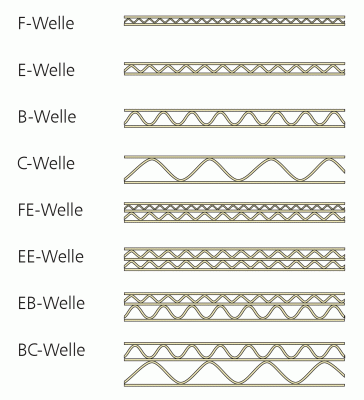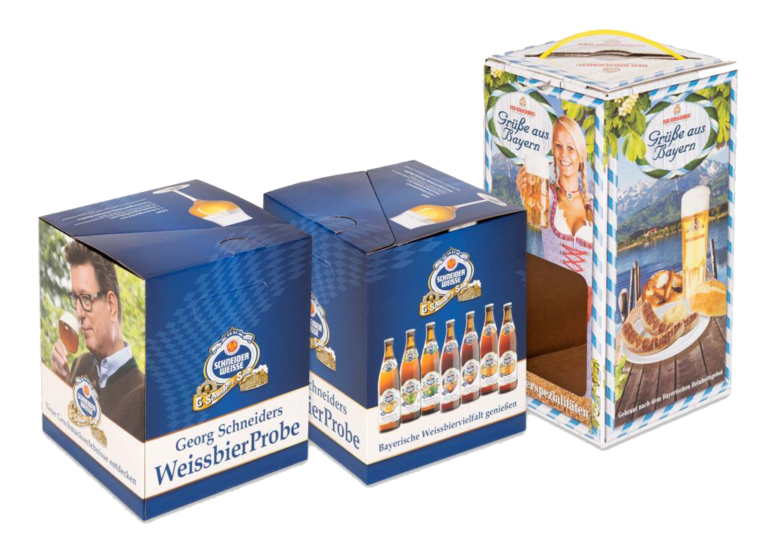Quality Management
Quality in perfection
Customer needs
To meet the needs of our customers, HANS KOLB Wellpappe GmbH & Co. KG has developed its quality procedures to perfection. The careful selection of the raw materials and lab examinations of supplies and the finished product ensure that the quality of our packaging is fully documented. Find out more about the tests we carry out. Contact us for a detailed schedule of the quality properties tested by us.


F-, E-, B-, C- and W-Flute
Flute types
Corrugated cardboard is first of all classified on the basis of the number of corrugated layers. The boards are available with different flute types, e.g. C – B – E- F – W-Flute, defined by their flute width and flute height. The grades range from fine to large. In double-wall corrugated cardboards, it is possible to combine different flute types with each other: BC – EB – FE.
The heavier the goods to be packed and the longer the transport distance, the greater the load the packaging must withstand (loading, climate, etc.). It is one of the great advantages of corrugated cardboard that it allows for the combination of various different raw materials. By choosing the right paper grade and grammature, it is possible to produce corrugated cardboard products of a defined strength, which in turn determines the properties of the packaging.
Quality assurance
Technical values
In sales negotiations with customers, we are often asked for technical testing data of a specific flute type.
The more effective the packaging, the better the goods are protected against damage, be it during transportation or storage. For certain cardboard grades, has developed specific quality standards, which have also been applied in the development of a German industrial standard for packaging material and corrugated products.

Principles for quality management measures
ISO certification
The EN ISO 9000 standards were devised to provide a system for the documentation of quality management measures.
They form a set of related standards for quality management systems and are aimed at harmonising national and international frameworks. Corrugated cardboard is subject to specific requirements and its production is thus controlled by specific quality assurance measures. In contrast, quality management systems are not product-specific and can thus be of similar structure, irrespective of the actual products and industry. Content of the ISO 9000 standards.
The successful establishment and management of an organisation requires clear structures and guidance. One way towards success can be the introduction and operation of a management system aimed at continuous improvement of performance by meeting the requirements of all parties involved in the process. In order to lead and guide an organisation, one requires a range of management systems, including one for quality.
EN ISO 9001 defines the requirements for a quality management system that enables an organisation to prove that its production processes meet the demands of customers and the applicable statutory regulations and helps improve customer satisfaction. This standard describes the entire quality management system in a general way.
The eight principles of quality management
- Customer orientation
- Leadership
- Involvement of persons
- Process-oriented approach
- System-oriented management approach
- Continued improvement
- Fact-based decision-making processes
- Supplier relationships of mutual benefit
The introduction of a quality management system in an organisation is a crucial strategic decision.
Principles for quality management measures
Quality testing
Grammature analysis
- Dismantling of finished corrugated cardboard product individual layers liner(s) & – flute(s)
- Drying of the individual layers
- Weighing of the individual layers
Separate weighing of
- Outer liner
- Flute(s)
- Inner liner(s)
Rubber diaphragm pushed through the corrugated cardboard. The top and bottom layers are burst through 5 times each (inner and outer side). The measured values in kPa are important indicators for the rigidity of the corrugated cardboard relative to pressure applied to a defined area.
In this test, the resistance of the material against pressure applied to one point is determined (e.g. damage caused by another box whose corner hits the top side of a corrugated cardboard box). The triangular pyramid breaks through the tensioned cardboard when the respective counterweight is applied (depending on the strength of the board). Unit: Joule
Strips of corrugated cardboard are pressed together at the edge in order to measure its resistance at right angles to the direction of the flutes.
A corrugated cardboard box is exposed to horizontal pressure until the side walls “buckle in”. This test is used to determine the maximum stacking height for heavy goods packed in boxes.
Strips of corrugated cardboard are pressed together at right angles to the fibre direction to determine the material’s stability at right angles to the machine direction.
Filled packaging units are dropped from defined height to the floor by releasing a spring catch mechanism. In this test, the protective properties of the packaging are determined. This is of particular importance for hazardous goods packaging.
In order to obtain qualitative and design parameter values, the thickness of the corrugated cardboard must be measured.
Being a certified inspection authority for dangerous goods packaging, we are more than familiar with the demands made on this kind of packaging. We are therefore also aware that packaging that has to be handled in special ways in particular cannot make any concessions to quality. We furthermore perform all relevant inspection and test procedures in-house.
